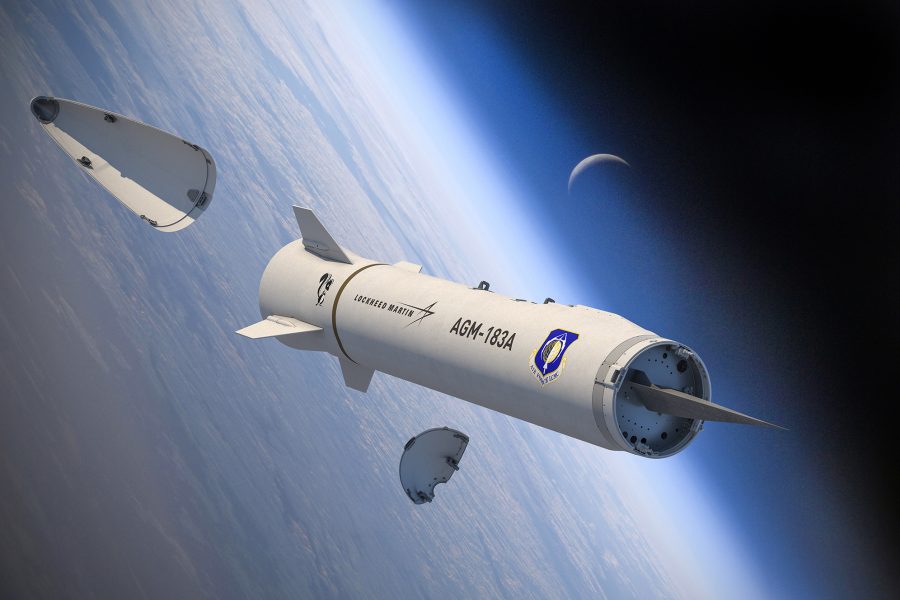The Air Force conducted what may be the last test of the AGM-183A Air-Launched Rapid Response Weapon on March 17. But the service is being cagey about whether the test was a success.
“A B-52H Stratofortress conducted a test of the All-Up-Round AGM-183A Air-launched Rapid Response Weapon” on March 17, local time, at the Reagan Test Site near Kwajalein Atoll, an Air Force spokesperson said. The bomber took off from Andersen Air Force Base, Guam.
“This test launched a full prototype operational hypersonic missile and focused on the ARRW’s end-to-end performance,” the spokesperson said. The Air Force “gained valuable insights into the capabilities of this new, cutting-edge technology” from the event, the spokesperson said.
However, the Air Force declined to say what the specific test objectives were or provide details such as length of flight, where it struck the surface, or whether all elements of the launch, separation, and glide sequence happened as expected.
The ARRW is a multi-stage, boost-glide weapon. After separation, a booster—which is adapted from the Army ATACMS missile—accelerates the weapon to hypersonic speed when a clamshell shroud falls away, and the hypersonic glide body then maneuvers to the target.
“This test acquired valuable, unique data, and was intended to further a range of hypersonic programs,” the spokesperson said, likely referencing the Hypersonic Attack Cruise Missile, or HACM. “We also validated and improved our test and evaluation capabilities for continued development of advanced hypersonic systems.”
Lockheed Martin Missile and Fire Control builds the ARRW. In March 2023, Air Force acquisition chief Andrew Hunter said the missile would not be pursued into production, after the last tests were conducted to wring whatever knowledge could be had from the project. The line item for ARRW was zeroed out in the fiscal year 2025 budget request submitted to Congress last week. Previously, the ARRW had strung together mixed results from testing. The last all-up round tests in fiscal 2023 appear to have been successes.
However, in recent testimony, senior Pentagon leaders have been less definitive about the ARRW’s future. Pentagon acquisition and sustainment chief William LaPlante deferred questions about ARRW production to a closed session during a House Armed Services Committee hearing in February, testifying that “there is a plan—it’s not something we can talk about in this open session.”
Last week, Air Force Lt. Gen. Dale White, principal uniformed deputy to Hunter, told the HASC that future ARRW production decisions “are pending final analysis of all flight test data.”
He said the next event would be “the final test of the all-up round,” with completion by “the end of the second quarter, fiscal year 2024.”
White said the Air Force was shifting near-term missile research to the HACM program and long-term research to reusable hypersonic platforms.
The imminence of the ARRW test has been an open secret since early March, when the Air Force published photos of all-up round No. 5 on a B-52 wing pylon at Andersen, where the service said it was conducting “hypersonic familiarization training” with air and ground crews. Naval surface test monitoring vessels and Missile Defense Agency monitoring aircraft were deployed to the Kwajalein area. The government issued Notice to Airmen warnings of a weapon test launch in the area.
While much of ARRW remains classified, the Air Force has disclosed that Lockheed’s mid-tier acquisition program contract called for a rapid prototyping effort, followed by testing and demonstration of readiness for production, with a number of “leave behind,” operationally-usable assets—leftover missiles—to be produced.
The ARRW’s size requires that it be launched from a bomber, but the HACM will be small enough to be carried by fighter-sized aircraft. Its air-breathing scramjet engine will also give it longer range than ARRW, USAF officials have said.
Though ARRW was zeroed out in fiscal 2025, the Air Force’s budget request calls for $517 million for HACM development in the next fiscal year, and more than $1 billion through 2029, described in budget documents as the development “completion date.” However, its funding profile declines every year of the future-years defense plan, and no long-lead funding in the procurement budget out-years.

